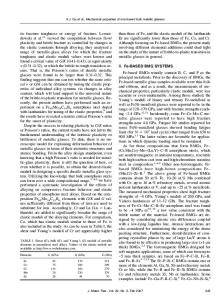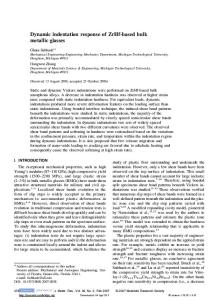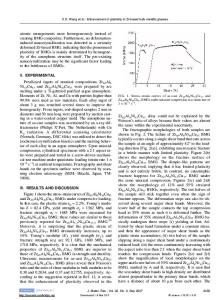New Calcium Based Bulk Metallic Glasses
- PDF / 540,384 Bytes
- 6 Pages / 612 x 792 pts (letter) Page_size
- 57 Downloads / 393 Views
MM2.8.1
New Calcium Based Bulk Metallic Glasses Oleg N. Senkov and J. Mike Scott UES, Inc., 4401 Dayton-Xenia Road, Dayton, Ohio 45432-1894. ABSTRACT Thermal properties of a number of new Ca-based bulk metallic glasses are reported and discussed here. The compositional range of the new metallic glasses follows the formula: CaA(Y,Ln)B(Mg,Sn)C(Ga,Zn,Al,Ag)D(Cu,Ni)E, where A ranges from 0.40 to 0.70, B = 0 to 0.25, C = 0 to 0.25, D = 0 to 0.35, E = 0 to 0.35, A+B+C+D+E=1, and Ln represents the La group elements. The alloys have been developed based on specific criteria predicted from Senkov-Miracle topological and thermodynamic models for metallic glass formation, which narrow the compositional range for searching new metallic glasses. INTRODUCTION Development of new metallic glasses is a very challenging process of selection and screening of different element combinations. A number of attempts have been made to understand the mechanism of amorphization in order to predict alloy compositions with high glass forming ability. Three empirical rules have been defined for the bulk amorphous alloy systems [1,2]. These are (a) requirement of three or more elements; (b) significant difference in atomic size ratios above about 12% among the three main constituent elements; and (c) negative heats of mixing among the three main constituent elements. The third rule reflects an experimental observation that the glass formation composition range generally coincides with a eutectic region and/or low liquidus temperature [2,3]. Although these empirical rules give useful directions, they are rather general, and a large number of failures and a huge amount of manual labor precede each successfully identified amorphous alloy. In this paper, additional and more specific criteria for easy glass-forming alloy systems are formulated which narrow selection of the alloying elements and their concentrations. These new criteria are based on results of recent experimental and theoretical findings of strong correlations between topological parameters, such as the relative atomic size R1 and concentration C of an alloying element, and glass forming ability [4-8]. In particular, most of the bulk amorphous alloys were found to have a characteristic dependence of C on R [4,5]. The solvent element generally has the largest atom size in these systems. Atomic concentrations of other alloying elements decrease, show a minimum at an intermediate atomic size, and then increase with decreasing atomic size, so that the smallest element often has the second highest concentration. This concave upward shape of the so-called atomic size distribution plot (ASDP) for bulk amorphous alloys is completely different from the concave downward shape for marginal amorphous alloys, in which the main element (solvent) has an intermediate size 1
R is defined as the radius of the solute atom divided by the radius of the solvent atom.
MM2.8.2
[4,5]. These characteristic atomic size distributions correlate with low molar volume and high packing efficiency of atoms in bulk
Data Loading...











